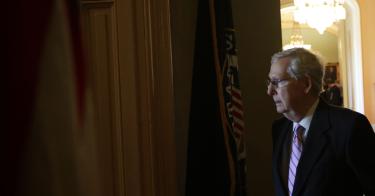In a recent series of tweets, American Enterprise Institute scholar Norman Ornstein made some assertions about the judicial-confirmation process that should not go unchallenged.
He tweeted that, prior to November 2013, then-Senate minority leader Mitch McConnell (R-Ky.) “singlehandedly broke the norms and altered the way the filibuster had been used, making it a fulltime weapon of mass obstruction.” He does not say what those norms were nor how McConnell singlehandedly broke them.
Senate Rule 22 provides a formal process to invoke cloture, or end debate, on a matter pending before the Senate. The Senate votes on a motion to invoke cloture two days after it is filed. Since 1975, Rule 22 has required “three-fifths of the Senators duly chosen and sworn,” or 60 votes, to invoke cloture and a filibuster occurs if that threshold is not met. In November 2013, Senate Democrats used a parliamentary ruling to reinterpret “three-fifths” in Rule 22 to mean “simple majority,” effectively abolishing nomination filibusters.
Between 1949, when Rule 22 could apply to nominations, and 2000, the Senate confirmed more than 2000 judges but took just 12 cloture votes. Only four of those cloture votes failed, resulting in filibusters, but only one of those nominees was never confirmed.
The norm prior to 2001, therefore, was that the filibuster was part of the legislative, but not the confirmation, process. In early 2001, Senate Democrats held a retreat in Florida at which they planned how to, as the New York Times described it, “challenge the [Bush] White House on judicial nominees.” This involved a strategy to “change the ground rules” of the confirmation process, including using the filibuster to defeat nominees who had enough votes for confirmation. This sounds very much like, in Ornstein’s words, plotting to break the norms and alter the way the filibuster had been used.
That’s exactly what they did. During President George W. Bush’s first term, Democrats forced the Senate to take 23 cloture votes (more than in the previous 50 years combined) on 13 different judicial nominations. Twenty of those cloture votes failed, resulting in filibusters.
During the first five years of the Obama administration, with McConnell as Minority Leader, the Senate took 12 cloture votes on judicial nominations. Cloture votes on six nominees failed, resulting in filibusters. That’s where things stood in November 2013. The Senate had confirmed 209 of Obama’s nominees to life-tenured federal courts by then. Of the nominees receiving any opposition at all, half had fewer than ten negative confirmation votes.
Democrats deliberately changed the filibuster norm during the George W. Bush administration, launching 20 filibusters that kept five judicial nominations from confirmation. During the Obama administration, Republicans launched six filibusters that kept five judicial nominations from confirmation.
McConnell did not, indeed could not, do anything singlehandedly. And he did not, singlehandedly or otherwise, break the norms or alter the way the filibuster had been used. Those norms had already been broken; that way had already been altered.
During the Obama presidency, Senate filibusters declined by more than two-thirds from what they had been under his predecessor. I simply can’t comprehend how this can be described as “making [the filibuster] a fulltime weapon of mass obstruction.”
This piece originally appeared in National Review




